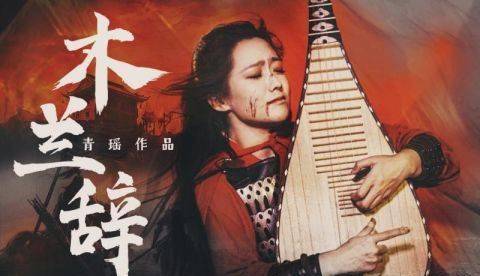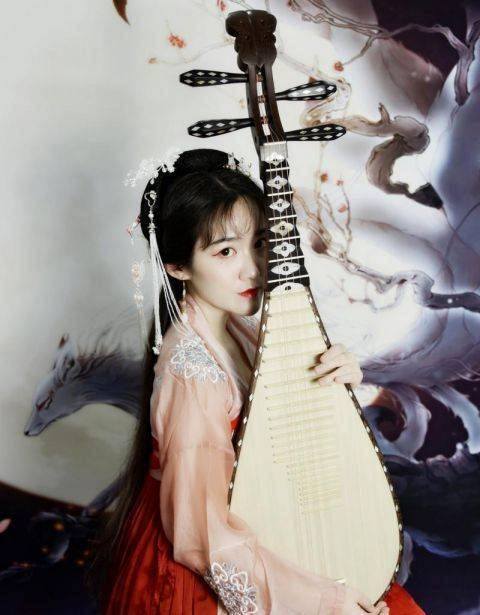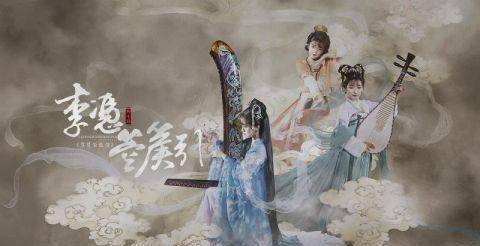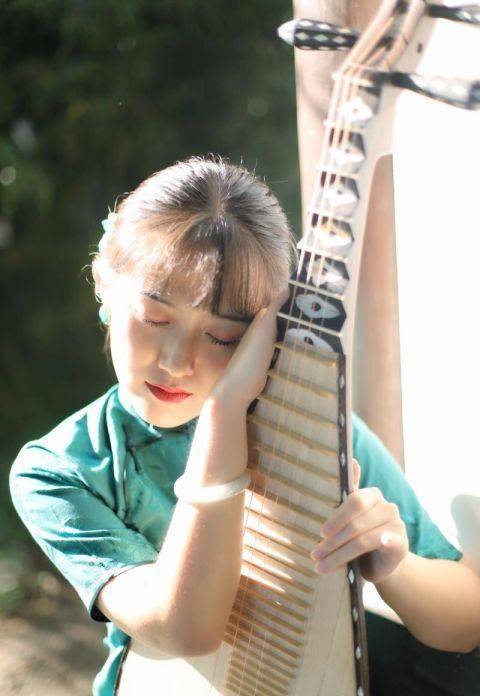The "Li Ziqi" in the Chinese music industry is super burning!

In the recent large-scale non-genetic inheritance and innovative cultural program "Very Legendary" broadcast by CCTV, Liu Qingyao, the promoter of the pipa, embraced the pipa, and together with the sound of the war drum and the actors, used a song "The King of Lanling Enters the Battle" to express The audience presented the magnificent life of King Lanling. Its quaint ethnic shape and the skillful skills of gently twisting and twisting make netizens constantly sigh, it is really "too burning!"
Liu Qingyao, whose real name is Liu Jing, is a girl from Tianjin. She began to learn Pipa at the age of 5, and successively studied with a number of Pipa performers from the Central Conservatory of Music and Tianjin Conservatory of Music. She began to learn Bel Canto and other ethnic musical instruments such as bamboo flute and guzheng when she was a teenager. In 2008, she was admitted to the School of Foreign Languages of Nanjing University, and then went to the Chinese University of Hong Kong to study for a master's degree in history.
After graduating, Liu Jing joined an Internet company as an operations manager. The job content is to combine products with hot spots and promote them in a way that young people like. In the process of contacting pan-entertainment products such as movies, animation, games, and online literature, Liu Jing also came up with an idea: Can she use the power of pan-entertainment IP and combine her marketing expertise to promote folk music? Therefore, from the end of 2016, she used the pipa to cover popular film and television songs, and released it on the Internet platform under the name of "Liu Qingyao", gaining a large number of fans.
Today, with the unique Chinese music video, Liu Qingyao frequently appears in CCTV's "National Treasure" and other programs, and has gained a lot of fans at station B, and is known as the "Li Ziqi" of the Chinese music industry.
Everyone will recite "Fifty strings for no reason, one string and one pillar to think about the Chinese New Year", but how many people have really heard the voice of Se?
Liu Qingyao said that it is a "good luck" that she can start learning the pipa from the age of four or five. But when she was a child, she felt that the folk band she was in was "a little dirty". "When I was a child, I saw other children wearing ballet skirts, or very delicate dresses like the symphony orchestra, and I thought they were more 'trendy' than the clothes of our folk orchestra." Liu Qingyao said, "The repertoire played in the orchestra at that time was also <Beautiful Moon and Full Moon> <Joyful> <Step by Step> and other familiar music, I feel a bit 'old-fashioned'."
Since his youth, Liu Qingyao has performed and communicated in many countries and regions with the Ministry of Foreign Affairs and the Chinese People's Association for Friendship with Foreign Countries. These experiences have strengthened her pride in folk music day by day. For foreign audiences, the performances of folk music are more representative. There are more than a dozen works in a concert, including the music of Jiangnan Sizhu, the music of the frontier ethnic minorities, ancient and modern. "It actually gives Western What the audience presents is a very three-dimensional China of five thousand years, as well as images from different regions and vast land and resources.” Liu Qingyao said.
What fascinated her even more was the fact that ethnic musical instruments could arouse the audience's thinking about Chinese literary classics and Chinese stories. "We learned Li Shangyin's <Jinse> in high school, and everyone would recite 'Jinse has fifty strings for no reason, and one string and one pillar thinks of China', but how many people have really heard the voice of Se? Li He's <Li Reference by Konghou> Comparing the sound of a Konghou to the chirping of a distant phoenix, how many people know what a Konghou is like?"
Based on the idea of "representing" the musical instruments described in poetry, starting from September 2019, Liu Qingyao chose Se, Konghou and Ruan Xian as the protagonists to launch the "Chinese Musical Instruments" series, and successively launched <Jinse>< Li Ping Kong Hou Yin> "Xiao Yin listens to Ruan Xian" three works. To make it easier for the audience to understand, she also added lyrics and vocals to the music.
The series of works are updated synchronously on Facebook and other overseas social media platforms, reprinted by many music media accounts, and received hundreds of thousands of subscriptions and views.

Guzheng can express the sound of running water ticking, erhu can imitate the neighing of a horse, let the instrument tell its own story
After the "Chinese Musical Instruments" series, Liu Qingyao began to try to make music based on the performance of musical instruments, and let the musical instruments replace the human voice as the protagonist of the story to interpret the story. "Chinese musical instruments have very rich expressive power, not only musical sounds, but also their own language system." For example, the guzheng can express the sound of running water ticking, and the erhu can imitate the neighing of a horse. In the work <Lanling King Entering the Battle Song>, she used the lute to play the melody itself, and at the same time imitated the sounds of golden arms and iron horses, short arms, horses neighing and drums vibrating. "At first, I thought about whether to go to Hengdian to hire a martial arts instructor and invite some actors to film the plot, but in the end I decided to let the performance be the protagonist and let the instrument tell the story by itself."
In Liu Qingyao's view, "Chinese folk music is quite different from Western music. Western music may be more about harmony. It is meshed, while folk music is actually a linear melody." For example, the well-known folk music << Jasmine Flower>, even without chords, playing with a single instrument is very nice, not only because the melody itself is beautiful, but also because many of the tunes come from local operas in our country. Rooted in the blood of the Chinese people, it is both traditional and developed, with rich heritage and vitality.
This idea has also achieved initial success. The "Lanling King's Entry Song", performed by her and Wang Jianan, the chief percussionist of the China Opera and Dance Theater, incorporates traditional musical instruments such as Jian drum, Chinese hall drum, and pipa, which is majestic and exciting. Since its release in April 2020, the cumulative number of broadcasts on the entire network has reached 10 million, with more than 7 million broadcasts on one platform of Station B alone, and more than 500,000 favorite users.

All the musical instruments on the Dunhuang frescoes are used to make the expression as authentic as possible
In "Dunhuang Music and Dance Wall", Liu Qingyao wears a stone green dance costume, has a flying bun on her hair, and plays with a variety of musical instruments in her arms. After the video was released, many viewers left messages such as "Dunhuang murals are alive" and "Dream back to Tang Dynasty".
Unlike most music creators, Liu Qingyao chooses to use video as a carrier to spread Chinese music. Therefore, in the creative process, in addition to composing music, the idea of shooting scripts is particularly important. "Without lyrics, it was a very big challenge for me to make up a story to concretize the musical language." During the preparation process, Liu Qingyao learned arts such as recitation and dance, and went to experience immersive dramas and even escape rooms. many games.
Not only that, in Liu Qingyao's view, the process of making an original Chinese music video is a bit like writing a paper. You need to consult materials, ask experts, and accumulate relevant historical and cultural knowledge. In order to make "Dunhuang Music and Dance Wall", Liu Qingyao went to Dunhuang specifically, "I once read a picture book about Dunhuang Cave 45, but when I actually went to Dunhuang and walked into Cave 45, I found that the Buddha statue inside was drooping. Yes." You have to squat down and look up before you can see "God's gaze", "this is completely impossible to show in the picture book."
In order to express as authentically as possible, Liu Qingyao decided to use all the musical instruments on the murals. Therefore, <Dunhuang Music and Dance Wall> selected several musical instruments that appeared most frequently in Dunhuang frescoes, such as the pipa that appeared more than 700 times, the Konghou that appeared more than 300 times, and the classic Lotus Ruan, etc. Among them, Lianhua Ruan, because of the epidemic, the Central Ethnic Music Troupe suspended performances and could not borrow instruments. She also specially asked a master to re-engraved one.
As for the costumes in "Lanling King's Entry into Battle", the samurai shirts worn by Wang Jianan and the wide-sleeved shirts worn by Liu Qingyao are based on the pottery figurines and murals unearthed from the tomb of Emperor Gaoyang of the Northern Qi Dynasty. Clothing style making.

Do a living work, not a momentary Internet celebrity
Although his own videos feature folk music, Liu Qingyao does not reject Western music.
In the latest <Mulan Ci>, in addition to playing the pipa as the main melody, Liu Qingyao cooperated with the Hungarian National Symphony Orchestra and added symphonic elements to the works. Inspired by the national hero Hua Mulan, <Mulan Ci> tells the story of Hua Mulan fighting the battlefield and dreaming of returning to her hometown. "The symphony as the background can set off the atmosphere very well." In addition, in the episode of Dreaming Back to Hometown, string music such as violin and cello are more suitable for creating a soft atmosphere. "In this work, Chinese music and Western music complement each other and complement each other. accomplished". The symphony is also used to better promote Chinese music. "I hope there will be more pipa concertos. After all, for most foreign audiences, music groups with Western symphonies are more acceptable and feel more friendly." <Mulan Ci> has reached more than one million views on station B, making many viewers "tear", and many people left comments such as "I actually listened to pure music and cried."
As a self-media person, Liu Qingyao used to inevitably pay attention to traffic, paying attention to "how many people have seen the work after it is released? How many people can I influence?" But now, Liu Qingyao said that his attitude towards traffic has changed to "a good meal is not afraid of being late" —— "I no longer think about blindly capturing the temporary market. The quality of a work is not determined by a group of people, nor is it determined by a period of time." Liu Qingyao said, "A work with real vitality, both If you have technology and depth, you have to add your own thinking. Only in this way can you truly move people and truly have vitality, rather than being a momentary Internet celebrity.”
 渝公网安备 50010702504639号
渝公网安备 50010702504639号